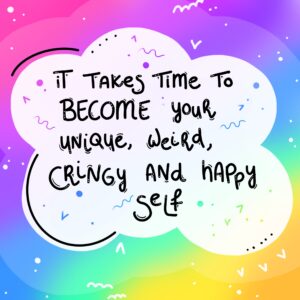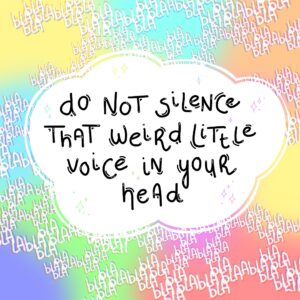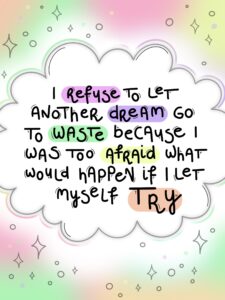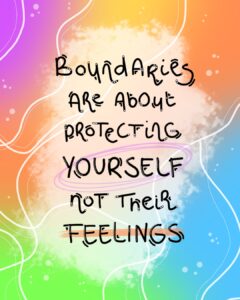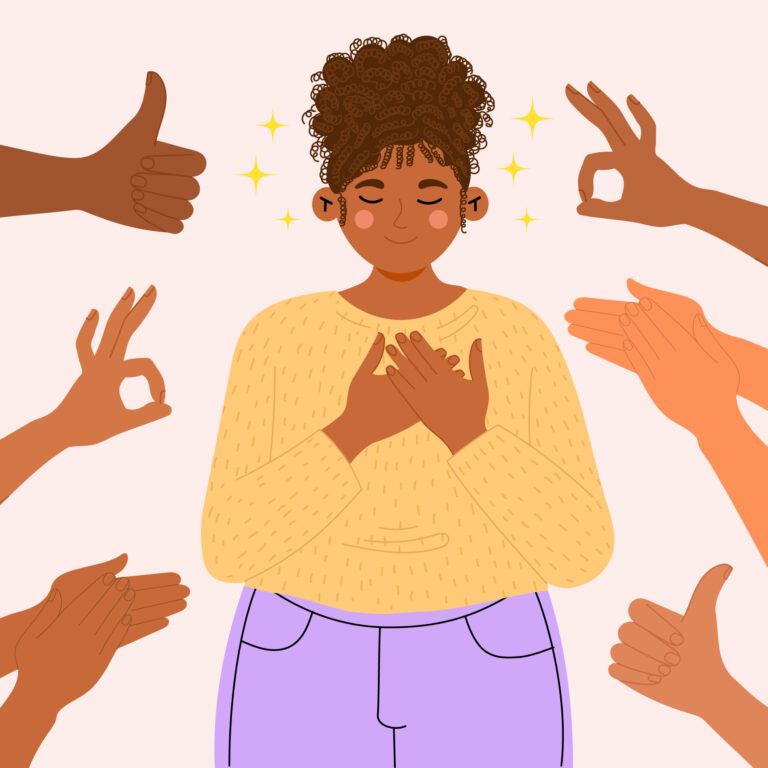Creating habits to reach goals: a complete guide
How to restructure your life to reach every goal you set
Do you struggle with creating habits and sticking to them? Do you set goals for yourself without knowing how to actually get there? Then this blog is for you. Because there are some simple steps you can take to set up your new habits to reach your goals and finally, unapologetically thrive.
There once was a girl who was cursed with an unhelpful habit, one that she would rather be rid of sooner than later. It was the inability to stay in touch with the people close to her.
Every time she was called upon by someone she loved, she would let the call go unanswered, leaving it patiently waiting in her inbox with all the other calls and messages. There it remained for days, weeks and sometimes months.
Until the caller slowly forgot about her.
A shadow of a memory that stayed with them for some time, only to be blown away by the wind tugging at it for weeks. Clearly what she needed was good habits to reach her goals.
All day the girl wondered what she could do differently. She wondered if there was something she could do to change her ways.
There was. Of course there was.
This girl just needed to get clear on what she wanted and get into the habit of replying to the damn messages.
And so I did.
To be completely honest, it was not that hard. All I needed was a clear goal, a desire to change something and a way to get there. But before I figured out what it was that I actually needed to change, the habit of replying to my unread messages seemed just impossible.
I tried everything: putting it on my calendar, setting reminders, trying to make it easier by not replying to everyone at once. All of these little tweaks and changes would get me two or three weeks of results. After that I simply gave up again. Too much work, too much effort, too much time.
Short summary for quick readers
- There are a lot of things that we think we do on auto-pilot but that are actually conditioned into us. And that means we can learn new habits too.
- In order to create a habit, you have to have the desire to reach a goal. Doing something for *you* is easier than doing something because people think you should.
- But just having a goal isn't enough. It determines what the habit should look like but the habit needs to be set up so you'll stick to it. You need to make them irresistible.
- Timing is everything: your habits should be related to a time and place. Plan it during a time that feels natural and in a place that helps you remember.
- Embed your habits: combine your habit with something you already do so it becomes an automated string of actions.
- Treat yourself: a reward is a great way to work on a habit. Try to plan a not-so-fun habit before a fun one so you'll get a reward for doing the boring thing.
- Use tools: it can help to use trackers and apps to help you stick to your habits and track your progress. Set timers or turn on notifications.
- Consistency isn't about doing it every single day without fail. It's about accepting that you might forget and trying again the next day. No shame, just acceptance.
* Free wallpaper download * Free wallpaper download * Free wallpaper download
* Free wallpaper download * Free wallpaper download * Free wallpaper download
Breaking bad habits to reach your goals
Are you aware of all the things we do on auto-pilot?
So many motions we go through daily are completely automatic. You could do them while being half asleep. Like going to the bathroom in the middle of the night. Whenever I get back to bed I wonder if I even flushed because I can’t even remember executing the action. But I always do.
And it would be nearly impossible to stop doing this because my mind has carved the pattern into my body and my limbs blindly follow command. It’s an automatic response that is hard to ignore. Like when someone throws a ball right at your face with the assignment to keep your hands on your back.
You’re bound to cover your face.
But guess what? You weren’t born with the habit of flushing after a midnight pee. You weren’t born performing any of the habits you perform on a daily basis. Which means that you learned them.
And that means you can learn more. Or unlearn the unwanted ones. Which is exactly what we’re going for here.
We need to build some habits that help us reach the goals we want.
We’re going to Pavlov the crap out of ourselves to condition the automatic habits needed to get to where we want to go. When you create a new habit and stick to it long enough, your body will start to execute the motions needed to perform the habit without you having to push yourself to do it. As soon as the bell rings you’ll start to drool.
So let’s find the bell, shall we?
Reach my goals: habits to get what I want most
I mentioned something about desire before. Desire is an important part of reaching your goals. Because desire helps you stay motivated in the beginning of the process. If you set a goal that isn’t really yours, you might not feel enough desire to stick to it when things get hard.
Sometimes people say they ‘should do’ more of this or ‘should be’ more of that. All because they read about it or someone told them so.
If you want to go to the gym more because you heard that working out four times a week is good for you but you hate the gym, then it will be hard for you to stick to this new habit. That doesn’t mean you won’t be able to exercise more. It means you have to find a habit to match your desire. Maybe you always wanted to dance or maybe you like boxing. Then follow that desire and incorporate it into your goal. Desire has to be your own in order for it to guide you towards the goal. And so we set the habits to reach the goals according to the desire.
Don’t set goals other people want you to reach while you have no desire to reach them.
If it is something you should change because it is harming you or the people around you, then find the desire to match the goal. Like switching from cigarettes to vaping. Still not great but it is a small step towards quitting smoking entirely.
And you know; we take small steps to where we are going.
You need goals to reach
Yeah, I do have to get back to the goal talk for a little bit. If you have not read my blog post about setting personal goals yet, then I would recommend you check that out first here.
What I want you to keep in mind while working on goals and habits is that the goal is the direction, working towards it is the process that you can create with the daily habits you choose to perform. This means that you need both habits and goals to get where you want to go. Which is why we need to be clear on our goal in order to talk about the habits needed to get there.
If you have read my work before, you know I am a huge fan of examples. I LOVE painting a picture of what I am talking about. So, let’s get into another example to get more specific about this habit stuff.
My goal used to be to read more (spoiler alert: I read 17 books since I started this goal 6 months ago).
How hard can it be?
That’s probably what you are thinking to yourself: ‘Just pick up a book and read’. That’s what I thought every time I bought a book with the idea of starting to get into reading again. I used to read 7 books a week when I was a kid. How hard could it be?
Well, apparently for me it was very hard.
Every time I bought a new book and every time I vowed to actually read more. I ended up with over fifty unread books on my shelf and even more on my ‘want to read’-list.
It is because I didn’t have a clear idea about what I actually wanted to do with this goal and when I wanted to do it; an important part of creating habits to reach your goals. If you want to get into this in more detail, I would recommend you to read ‘Atomic Habits’ by James Clear or to visit his website right here.
What comes after I set the goal?
So just having a clear goal is not enough. The goal determines what the habit will look like but the habit should also stick to some pointers for it to work. What do you think would happen if I just said I wanted to write more and then randomly grabbed my laptop whenever I felt like it?
Well, let’s think about what happens when I never feel like it. Or when my day gets filled up with other stuff. This ‘whenever I feel like it’-habit (that isn’t really a habit) is the first to go. And then I forget about it the day after and the day after until I decide to start again three months later.
Because the desire is still there and the goal is too but I did not have the right process to get there.
Take the ‘read more’-goal as an example again. Let’s say we already made the goal more specific and we determined that instead of never reading, we want to at least read once a week for twenty minutes.
What would be some habits to reach our goals?
Exactly. Picking up a book and reading it for twenty minutes every week. But like I said before: this shouldn’t be a ‘whenever I feel like it’ kind of thing. Because that is not a habit. A habit is behavior that sticks and becomes frequent. So we set up the process to match that definition.
Onto some clear pointers and tips!
How do we create habits and stick to them?
What we need to do is make this habit into something we can’t help but do. This habit needs to become the flushing of the toilet after a midnight pee. We need to make it irresistible. So let’s just do exactly that. Time to share some steps that help you create lasting habits, building a process that will guide you to reach your goals.
#1. Timing is everything when it comes to habits
Bedtime is a great example of a habit that is related to a certain time of day. You know that your body and mind gets tired in the evening. Every night at the same time, your eyes become heavy and when you try to fight it you might be able to get in an extra hour or two but eventually bedtime always wins (except when caffeine is part of the defense). Some people poop at the same time everyday, there are people who can’t walk into the kitchen without having to eat something. A lot of habits are related to a time or a place.
And your new habit should be too.
Pick a set time or place or situation to work on your habit. Like if you want to read for twenty minutes each week, you could decide to do it after you go to the gym or before dinner on Saturday, or whatever works for you.
If you connect your habit to a time or a place, your body will get used to this and execute the habit automatically when it is time to actually do it. Or when you pick the same comfortable chair to read in every week, you might pick up your book more easily when you settle yourself down on this reading throne.
I read for thirty minutes every morning when I get out of bed. I do it right after I journal; it is my reward for writing and because there is a set time and place for it (in the living room on the couch), it becomes an automatic thing. After I write down the last sentence in my journal, I pick up the book and disappear into the pages.
#2. Embed the habits to reach the goal
Combine your new habit with something you already automatically do. This creates a chain-reaction. Like how I read after I journal. This has become such an automated process, if I don’t read after writing I feel weird. My body executes the movements automatically; I put away the journal and pick up the book.
By creating a string of habits, you can actually make ‘less fun’ habits into something that isn’t as dreadful.
Remember how in the beginning I mentioned that I am horrible at responding to messages? It is not that I don’t like the people messaging me, I love them. It’s just that I hate being on my phone for that long and I hate the feeling of guilt when they message me and I don’t reply right away (or in the next weeks).
So I embedded the habit of replying to messages into my lunch routine (also a great place/time-habit). I prepare my lunch and while waiting for the microwave to finish or the toaster oven to beep, I open the ‘Whatsapp-messenger’ page on my computer. Then while eating lunch, I respond to every message that is unread at that moment. And just like that, I created one of the habits that will help me reach my goals.
Always keep the goal in mind
When people reply right away, I leave those messages unread. The goal is to respond to messages that are waiting in my inbox. New ones will have to wait till the next day. See how you stick to your original goal that way? I did not want to become a better texter by always replying instantly. I wanted to be better at replying to unread messages. You always stick to the specific (but not too specific) goal you set, so you don’t end up doing too much. That way it won’t feel like a fulltime job and you’ll be more likely to perform the habit again and again.
After finishing that task, I get to play a game as a reward, which has become a new lunch routine: lunch – messages – game. It would feel weird to reply to messages at another time and it would be weird to eat lunch without scrolling through my inbox; it’s automated.
Now that my friends know why I only ever message them at noon, it is time to look at something I have mentioned in both these tips; rewards.
#3 Rewards: Treat yourself
As you can see, I mentioned a reward in basically every habit example I gave you. A reward is a great way to make yourself work on the habit, even if it is something you don’t want to do.
If it is my turn to do the dishes in the evening, I do them right before it is time to go to bed because before I go to bed I get to write for my blog (which is also a habit I created). I could do the dishes at any other time if I wanted to but I chose this time to make blogging into the reward I need to perform the habit of doing dishes.
But a reward isn’t necessarily just for doing things you don’t want to do. I reward myself for basically every habit I perform. I do this because I am a rewards-oriented person; I thrive when I know there is gold at the end of the rainbow. Even if that rainbow isn’t that long or hard to climb.
If that is you, then create a reward-habit to match the other habit that you’re learning. Just make sure the habits don’t cancel each other out and are in conflict with the actual goal. A celebratory evening beer as a reward for not drinking beer at dinner is not really getting you where you want to go (unless your goal specifically stated that you could drink beer any time a day as long as it’s not during dinner).
So treat yourself. And why shouldn’t you? You’re learning a great new skill that will help you create the life you want to be living!
#4. Use tools to help you stick to the habit
Last but not least: get something to help you keep track of your habit and goals or find something that’ll help you remind you of said habit and goal. I use an app called ‘Bookly’ to keep track of my reading and it gives you little rewards for reading every day. You can set daily, monthly and yearly goals which makes you more eager to keep reading because I don’t want to break the streak.
If you want to read more but keep forgetting, put out the book as a reminder. Put it next to your bed if that’s where you want to do your reading.
Just make sure your reminder is somewhere you can see it. My reading app gives me a notification every day at the same time, reminding me to read. Now my reading is completely embedded into my morning routine but if there happened to be a morning where I did not have time to read, my app will still remind me at 7:30 pm every evening. That way I don’t forget about the habit and I can make up for it before bed if I wanted to.
If you put your reminder somewhere you can not see it, you will just as easily forget about the habit. So make sure your reminder is somewhere you will be sure to see it. That way it can actually function as a reminder and help you stick to your habits.
Consistency without shame
Now that we have set some clear pointers I am sure you can create some habits and reach some goals. But I do want to leave you with a little bit of advice for your goal-reaching journey.
You are not a machine. So even though your habit might be executed automatically, sometimes you just forget to flush the toilet.
It happens.
Sometimes life gets in the way, other times you’re not in the right place mentally or physically and sometimes you just plain forget. This is completely normal. If you were a computer programmed to perform the same task over and over again then you would be able to stick to this habit tirelessly. But you are a human being and these things happen.
The most important thing to keep in mind is to try again the next day. Some people tend to give up after missing a day. They shame themselves and make themselves out to be a failure because they couldn’t stick to the routine. But missing a day does not make you forget the routine. The trick is to get back on that horse and try again the next day.
That decision, the decision between giving up or trying again, determines whether or not you will succeed in creating consistent habits and with that to reach your first goals: the goal of creating long-lasting habits to lead you to success.




